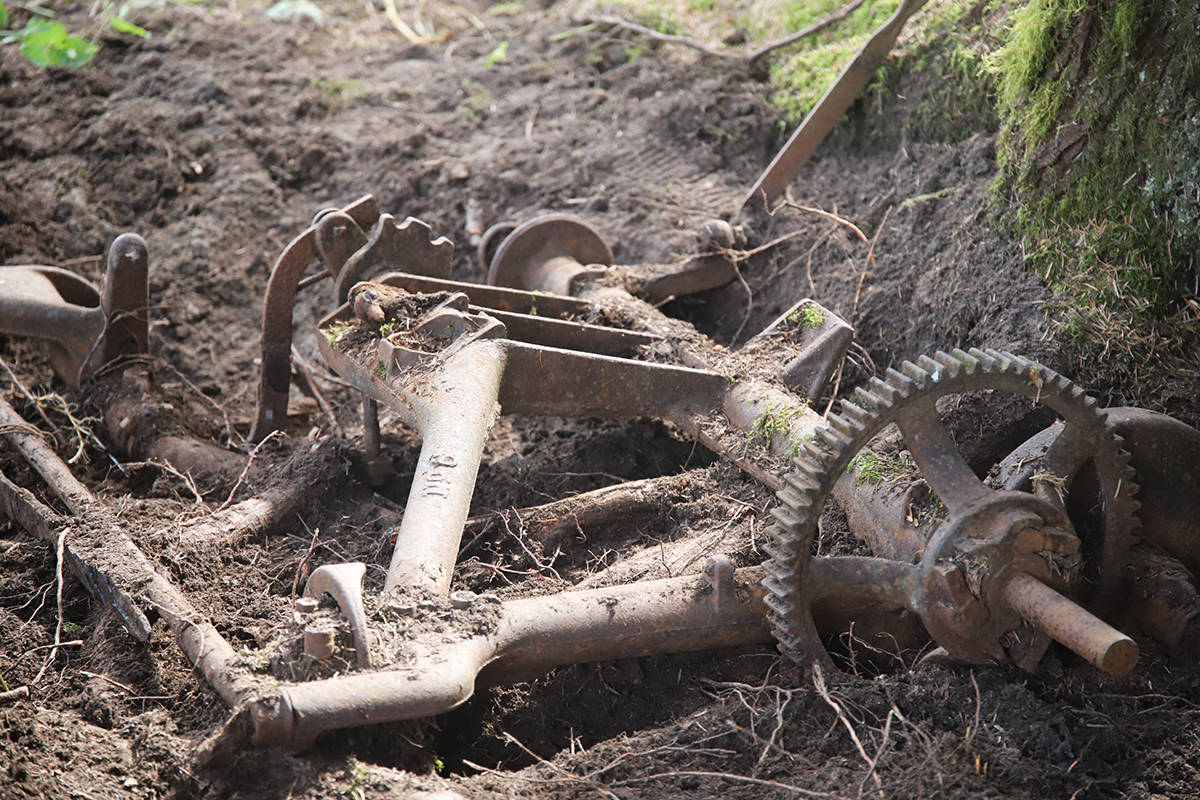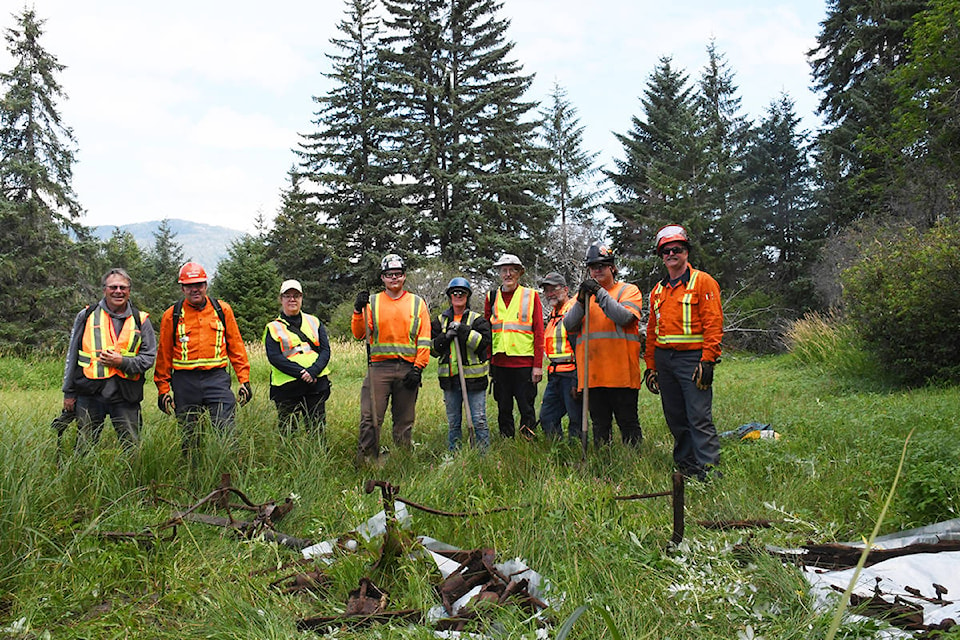By Walter Thorne
It’s a rainy day in July as members of Kitimat’s Heritage Group and Rio Tinto BC Works carefully pick their way through the bush not far from the aluminium smelter.
Their aim? Retrieving farming implements dotted around the site of an oft-forgotten piece of Kitimat history – the Anderson Farm – to save them from a rusty grave and preserve them for future generations of Kitimatians to see.
The group includes local historian and Northern Sentinel columnist Walter Thorne, Kitimat museum curator Louise Avery, and Peter Ponter, and BC Works’ Eve Normandin, Andy Lecuyer and Phil Hustad.
The ambitious project involved carefully retrieving the remnants, using a chopper to airlift some of the heavier pieces, to a storage facility on Forest Ave. where they await restoration.
What follows is an account of Anderson Farm written by Walter Thorne, previously published in the Northern Sentinel.
When George Anderson left his post at the Kitamaat Mission in 1903, his new residence wasn’t far away. In fact he was moving just five kilometres across Kitimat Arm to the west side of Kitimat’s river delta lands.
He was giving up his life as a lay minister to become, with his third wife Martha, a valley rancher/farmer. The lush grasslands and alluvial soil of the delta were just too attractive and Anderson had been using the property there for more than five years.
By 1910 improvements included a ranch house, barn and animal pens plus many additional buildings in the long ribbon settlement which extended north for more than a kilometre. The settlement grew up on the margins of grasslands along the western waterways of three streams which eventually became Anderson, Moore and Xatzy Creeks.
Within just a few years the Andersons had guest cabins, more barns, fencing and a summer church camp retreat for the girls home at Kitamaat Mission. There were various warehouses including one for the company Foley, Welsh and Stewart and a Royal Mail depot for the Canadian Postal Service – the ranch was the starting point for people attempting the government road to the Cable Car river crossing and the road on to the Hazeltons.
At the ranch, but in the waterways, were the operations for Mitchell and Hallet’s logging camp. They had a large floating scow-house, a bunkhouse for additional loggers and their various boats.
Reading the accounts of those years by Elizabeth Anderson Varley in her book Kitimat My Valley, it is clear the Andersons just had to be around people. They enjoyed company and were superb hosts.
They were forever putting up visitors, from government surveyors to pioneer travellers poised for a journey overland to the Interior. Almost all the prospective valley pioneers spent time in residence at Kouthpega, meaning “The place of the tree fungus” in the Haisla language.
People who stayed and lived at the ranch included Barney McConkey, Charlie and Lizzie Moore, Rudolph Braun, Alvin and Mabel Kepler, Aaron Brown, Henry List, Pete Long, Percy Mills, Jack Cole, Floyd and May Worthing, Charlie Carlson and, eventually, Jack Pine.
The Andersons liked the thought of prospective new neighbours and they went overboard to encourage them to stay. Often the new folk would stay at Anderson Ranch - sometimes working for George - while they prepared their own pioneer abodes.
Some of them lived at the ranch for more than a year while their own land allotments were sorted out. Such was the case with Rudolph Braun, the Worthings, Keplers and Moores. Valley neighbours would often arrive and depart from Kouthpega as they rendezvoused with the various steamships heading south out of Kitamaat Mission.
George and Martha were operating an early version of Kitimat’s Community Centre. Kitamaat Village folk came to witness and enjoy farm life and valley folk came for their Thanksgiving, Christmas and Easter celebrations where the food was legendary.
Additionally, the evenings included table games and lively music - George had the first valley gramophone and he encouraged neighbours to bring along their talents to ensure a good time for all.
Charlie Carlson usually arrived with his violin and some in the group had credible baritone voices which were effectively used in the usual popular hits and tunes. Some of the more popular ones were actually hymns like Rock of Ages.
Elizabeth confessed that despite her parents being religious, they were not above playing a fun card game like gin rummy.
The Andersons were compassionate, kind folk, always taking in the singletons, mostly men, who Elizabeth described as “lonely men in a weary land.”
It was a severe loss to the Kitimat valley pioneers when in 1921 the Andersons finally left. It was like the heart of the valley had been removed.
Yes, life had been a struggle, what with World War I and the loss of several valley youths, including Bert Anderson, the disappointments of the railroad going elsewhere and that constant battle with the capricious river freshets.
The river was continually eroding pasture lands and tearing out structures and fencing and Elizabeth well remembered the loss of the original ranch house to a rampaging November torrent.
The early 1900s were memorable years in the life of Kitimat and Kouthpega was the heart of it all. Far more than just a pioneer farm, it was a real community.

